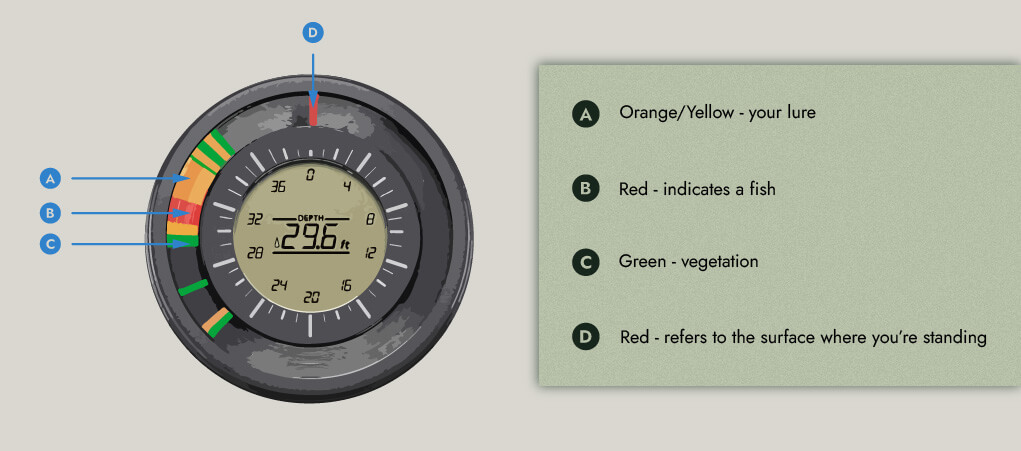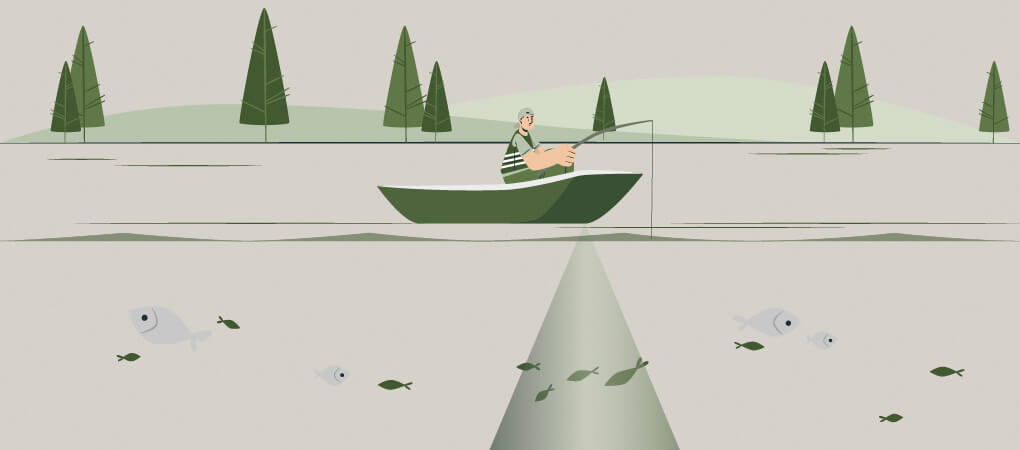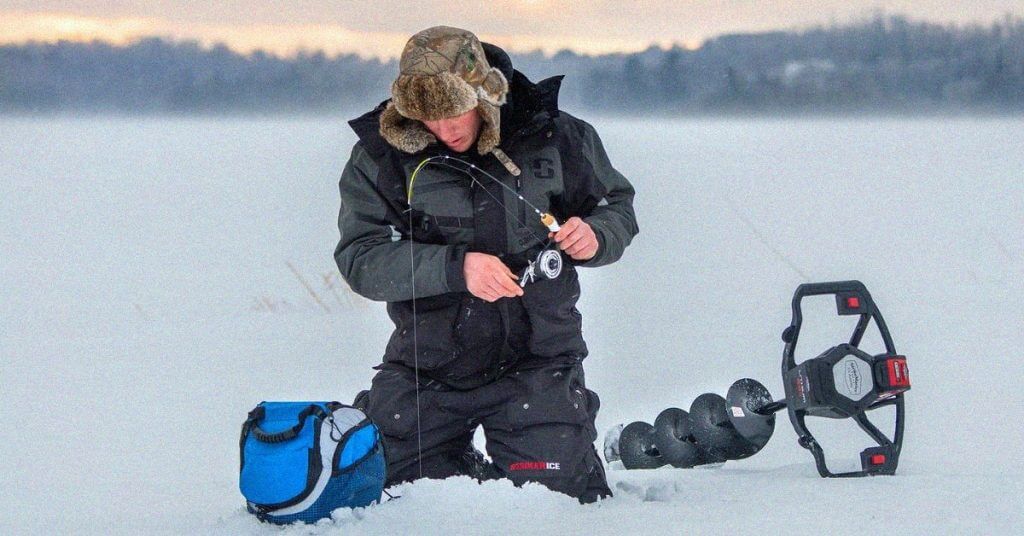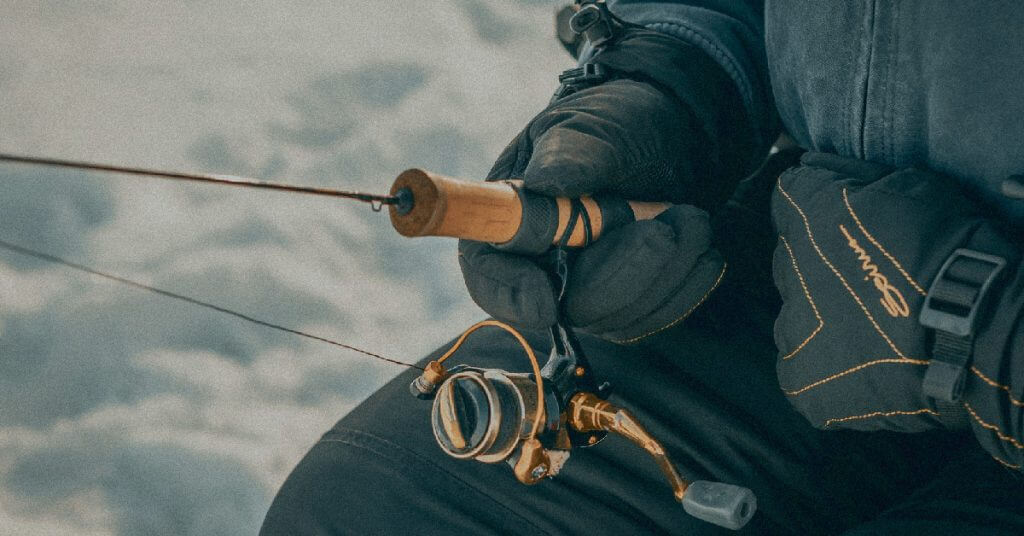In this article, we’re stacking the ice fishing fish finder vs flasher for ice fishing. These two pieces of fishing technology are totally different in terms of function and appearance but they essentially do the same thing.
They both help you find fish in different ways.
I’ve used both of these quite a bit and it’s like comparing apples to oranges.
The main goal of this article is to help understand how they differ and how they’re the same so you can choose one that works best for you.
Continue reading below to see the main differences between the fish finder vs flasher.
Fish Finder vs Flasher: Main Differences
The goal of any type of ice fishing electronic is to help you find more fish while ice fishing. Thankfully, even in a flasher vs fish finder comparison, you’ll find two equally capable pieces of technology.
They do have quite a few major differences though that could make one better than the other depending on who you’re talking to.
Let’s take a look at the major differences between these two.
Display

Alright, so the biggest difference is obviously the way the information is displayed and the way you interpret it. Let’s break it down.
Fish Finders
Fish finders do a few different things. They can use arc technology which is considered the most basic form of fish finding. You’ll read everything using a backlight LCD screen and finders display a lot of information such as digital depth, depth range, best fishing spots, and all kinds of details about the open water.
Whenever a fish appears on the chirp sonar, it’s indicated with the use of an arc. The size of the arc will tell you about the size of the fish and its location will obviously tell you how close it is to your lure. This has some pros and cons.
First, fish arc technology is generally better at picking up on every little fish than some other types. It usually has a lower target separation too which means it can pick up on a school of fish and identify it as multiple fish rather than one large fish.
The other popular type of fish finding technology is Fish ID. Once you strap up your ice fishing boots and hit the hard water, you’ll quickly discover that figuring out where to drill your hole is a challenge. You can have the best ice fishing auger on the market but if you’re not drilling where the fish are, what’s the point?
Fish ID uses actual fish graphics to tell you where the fish are. It’s simpler to read for amateur anglers and the size of the fish will vary based on the actual size of the fish in the water. I find that these aren’t able to pick up on as many fish but that is honestly pure opinion based on experience.
One of the primary pros of using a fish finder is the simplicity and ease of use. It’s very easy to turn a fish finder on and figure out what you’re doing. Of course, the process of installing a transducer on your boat or kayak can be a pain but they have small portable fish finders that make it easier. You can also drop them in the hole and use them for ice fishing as well.
Another advantage that only fish finders can provide is mapping, charting, and backtracking. Since there’s a natural delay between when the fish finder picks up on something and when it’s shown to you, opportunities are sometimes missed.
But, premium fish finders have something called an RTS split-screen window that allows you to backtrack and see what happened over the past few minutes or seconds.
In terms of durability, the best ice fishing fish finder will come in a carrying case that encloses the unit and protects it from ice and snow. They’re sold as an ice fishing bundle and popular options such as the Garmin Striker and Helix 7 also come with ice fishing options.
Ice Fishing Flashers
When amateur anglers look at an ice fishing flasher, they generally move on because they think it’s going to be over their head and that’s not entirely true. It looks far more complicated than it is and the technology is actually simpler and more accurate once you understand how to use it.

Color flashers come with a three-color color palette usually including green, yellow, orange, and red. These colors are used to indicate different things in the water such as vegetation, fish, and your lure.
In most cases, your lure is a yellow or orange color and red indicate a fish. As the fish moves closer to your lure, the red bar will move closer to the orange bar. If it moves farther away, then the red bar will separate from the orange bar.
As you progress and learn more about using flashers, you’ll discover that you can really fine-tune them to show you exactly what you want. You can zoom and dial in the sensitivity in a way that you can’t with a fish finder.

Another interesting thing about flashers is that they only work in a vertical column so it makes them the ideal choice for ice fishing. When you’re working your jig vertically in the water column, the flasher operates like a cone.
So, it sends the cone down into the water and as you get farther away from the sonar unit and more widespread in the water, the reading becomes less accurate. As you narrow down the cone thus lowering the range of space you can find fish in, the readings become more accurate.
GPS/Mapping
I spoke about it briefly but when it comes to fishing technology having GPS and mapping is a big plus. Many premium fish finders come with mapping technology that allows you to chart locations you’ve been, drop pins on places you want to go again, and navigate your way around the water with GPS.
When it comes to ice fishing, this takes on a whole new level because you can actually use pre-charted basemaps to identify things like vegetation, submerged points, humps, drop-offs, and different changes in structure. Keep in mind that fish generally hold to the same structure whether it’s cold or warm so identifying where fish were when it was warm will help you identify where they’ll be when it’s cold too.
Flashers do not offer this feature or anything close for that matter. They’re limited in what they offer but they do it pretty darn well. You may have to bring a portable GPS unit but you’re still not going to get the chart plotting and pre-loaded fishing lakes like you would on some of the best Garmin, Humminbird, or Lowrance units.
Speaking of brands really quick, a lot of the brands you see are different too in the flasher realm. Ice fishing brands like Marcum and Vexilar come out with more of their fishing gear.
Portability
When we compare the portability of an ice fishing fish finder vs a flasher, there isn’t too much of a difference but it depends on what kind of unit you get. They sell extremely portable fish finders whereas most ice fishing flashers are not as portable.
The one portability advantage of flashers though is that you generally get everything you need in one package. Fish finders may require you to purchase additional things from Amazon such as transducers and many of them need to be hooked up to your boat battery which could be a significant downside as well if you’re not too savvy with that kind of thing.
Fish finders that run off a portable battery generally have poor battery life.
Either way, if you’re looking for something portable you’ll want to go with a small handheld fish finder or the best flasher because neither of these things will require you to have a primary battery source.
Seasonality
Flashers are really only used for ice fishing. Fish finders can be used year-round in a variety of different situations. The reason flashers are only used for ice fishing is because the ice-ducer is actually designed to read through the ice. This gives them a huge advantage in ice fishing applications because you can identify an ideal fishing location before you start drilling.
I’m a fan of the ice fishing flashers that come with fish finders built-in. These combos are becoming more popular. You’re getting the best of both worlds and maximizing your ability to fish regardless of the situation. You’ll find this feature in finders like the Humminbird Ice Helix 5.
Ease of Use/Learning Curve
To be honest, neither of these are that hard to use once you figure it out but using an ice fishing flasher looks a lot more intimidating. Fish finders are more appealing, more people know what they do, and as a result – more anglers feel that they can learn how to use them easier.
As for flashers, if you’re not an ice angler, you may have never even heard of them. They have a lot of knobs and dials that require you to adjust, zoom, and play around with the sensitivity. This definitely has a learning curve but there are so many videos and helpful guides to take away some of the scariness.
If I had to choose one that is easier to use for a beginner angler, I would pick a fish finder. The most basic fish finder really just requires you to throw a transducer in the water and look for fish to pop up on the screen. It doesn’t get much easier than that. But, there are downsides. These types of fish finders are not accurate, you’ll miss a lot of fish, and you may be on a wild goose chase to nowhere.
When to Use a Fish Finder
As we compare an ice fishing fish finder vs flasher the main thing that people ask me is when they should use one over the other. There isn’t a right or wrong answer to this but the simple answer is: use a fish finder when the water is flowing. The obvious time you can’t use an ice fishing flasher is if you’re not fishing on the ice. Doesn’t get simpler than that right?
You can use a fish finder on ice but you can’t use a flasher off the ice. The best choice you can make is investing in an ice transducer for ice fishing sonar if you want to use the fish finder on the ice. This will enable you to get a more accurate reading because they’re designed for colder weather and you can read directly through the ice.
Keep in mind that reading through ice is not always a guarantee. It won’t work 100% of the time. Wet the ice, make sure it’s clear, and ensure that there isn’t any air trapped between the ice and the transducer.
When to Use an Ice Fishing Flasher
Alright, now, when do you use an ice fishing flasher instead of a fish finder? Well, whenever you want I guess. Again, there really isn’t a right answer to this. You would want to use a flasher in the event that you can’t use a fish finder. The only time this would be the case would be if you don’t have one.
Are ice fishing flashers better for ice fishing? That’s debatable but I find that they’re more accurate but they have limitations. Another advantage of a flasher is the lack of delay between what you’re seeing and what’s happening. Since you’re reading a vertical column of water rather than a widespread space, you need to react quickly.
Fish finders have a few-second delay whereas flashers operate with real-time sonar so you can actually see the fish approaching your lure and you can time your hookset better.
Final Thoughts: Should You Get a Fish Finder or a Flasher?
Looking at fish finders vs flashers just makes me want to get out there and start fishing. Unfortunately, at the time of writing, the lakes aren’t frozen over yet. As for you, if you’re figuring out which is the right choice, I can’t tell you, but I can offer my advice based on experience.
Start small and work your way up. Flashers are expensive and if you’ve never purchased a piece of fishing tech before, you don’t want that to be your first purchase. Get a small fish finder, some are less than $200 and try using it for your ice fishing. Just see how it works, how you can make adjustments, and how it can either help or hurt your fishing.
If you’re more experienced and you want to know how much of a difference a flasher would make, then get one because it’s a huge difference and a fun experience to watch the fish move around beneath you.
Flashers will tell you a lot once you know how to read them and they’re pretty durable and long-lasting as well so it’s a good long-term investment.
Enjoy and good luck out there!




